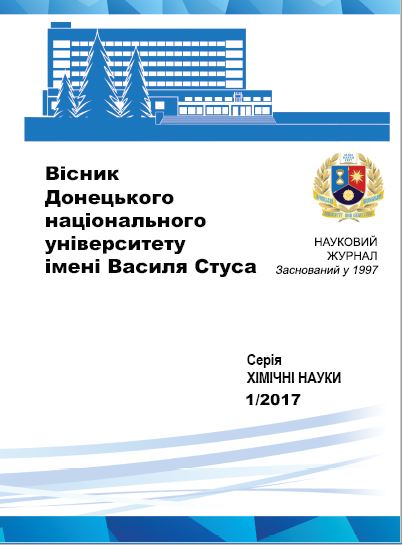A new approach for the determination of antiradical capacity of phenols in the reaction with cation-radical of 2,2′-azinobis(3-ethylbenzthiazoline-6-sulfonic acid).
DOI:
https://doi.org/10.31558/2617-0876.2017.1.4Keywords:
antiradical capacity, antioxidants, dihydroxybenzenes, dihydroxyphenilthiazoles, aqueous medium, ABTSAbstract
It has been substantiated an approach to determining the stoichiometric coefficient of the inhibition in the reaction with the cation-radical 2,2′-azinobis(3-ethylbenzthiazoline-6-sulfonic acid) (ABTS•+), which is allowed to exclude the effect of the antioxidant transformation products on the antiradical capacity. High antiradical capacity of dihydroxyphenylthiazole derivatives (DFT) in the reaction with ABTS•+ is caused by the products of DFT transformation. The mechanism of the process is discussed.References
Niki E. Assessment of antioxidant capacity in vitro and in vivo. Free Radical Biology and Medicine. 2010. Vol. 49. P.503-515.
Kinetics and mechanism of formation and decay of 2,2'-azinobis-(3-ethylbenzothiazole-6-sulphonate) radical cation in aqueous solution by inorganic peroxides / Venkatasubramanian L., Maruthamuthu P. Int. J. Chem. Kin. 1989. Vol.21. P. 399–421.
Kinetic matching approach applied to ABTS assay for high-throughput determination of total antioxidant capacity of food products / Magalhaes L.M., Barreiros L., Reis S., Segundo M.A. Journal of Food Composition and Analysis. 2014. P.187–194.
Stopped-flow method for assessment of pH and timing effect on the ABTS total antioxidant capacity assay / Labrinea E.P., Georgiou C.A. Analytica Chimica Acta. 2004. Vol. 526. P. 63–68.
Synthesis and antiradical and antibacterial activity of 4-(3',4'-dihydroxyphenyl)thiazole derivatives / Odaryuk V.V., Burakov N.I., Kanibolotskaya L.V. et al. Pharmaceutical Chemistry Journal. 2015. Vol. 49, N 2. P. 96–98
Синтез и изучение антиоксидатной активности 3,4–дигидроксифенилтиазолов / Шендрик А.Н., Ода- рюк В.В., Бураков Н.И. и др. // Журнал органической и фармацевтической химии. 2011. Т.9, вип. 4 (36). С. 61– 64.
Ueber Verbindungen des Thiazols(Pyridins der Thiophenreihe) / Hantzsch A., Weber J. H. Dtsch. Chemischen Berichte. 1887. V. 20, N 2. P. 3118–3132.
Antioxidant activity applying an improved ABTS•+ radical cation decolorization assay / Re R., Pellegrini N., Proteggente A. et al. Free Rad. Biol. Med. 1999. Vol. 26, N 9/10. P 231–1237.
Comparative reaction rates of various antioxidants with ABTS radical cation / Walker R.B., Everette J.D. J. Agric. Food Chem. 2009. Vol. 57, N 4. P. 1156-1161.
ABTS radical-driven oxidation of polyphenols: Isolation and structural elucidation of covalent adducts / Osman A. M., Wong K. K. Y., Fernyhough A. Biochemical and Biophysical Research Communications. 2006. Vol. 346, N 1. P. 321–329.
Индукционный период образования ABTS•+ как характеристика антирадикальной активности ряда природных антиоксидантов / Ильясов И. Р., Белоборо- дов В. Л., Тюкавкина Н. А. Фармацевтическая химия и фармакогнозия. 2008. № 8. С. 14–18.
Антирадикальная способность фенольных ан- тиоксидантов по отношению к катион-радикалу 2,2'- азино-бис(3-этилбензтиазолин-6-сульфоновой кис- лоты) / Одарюк В.В., Одарюк И.Д., Каниболоцкая Л.В., Шендрик А.Н. Вестник Донецкого национального университета. Сер. Природничі науки. 2014. № 2. С. 121–125.

